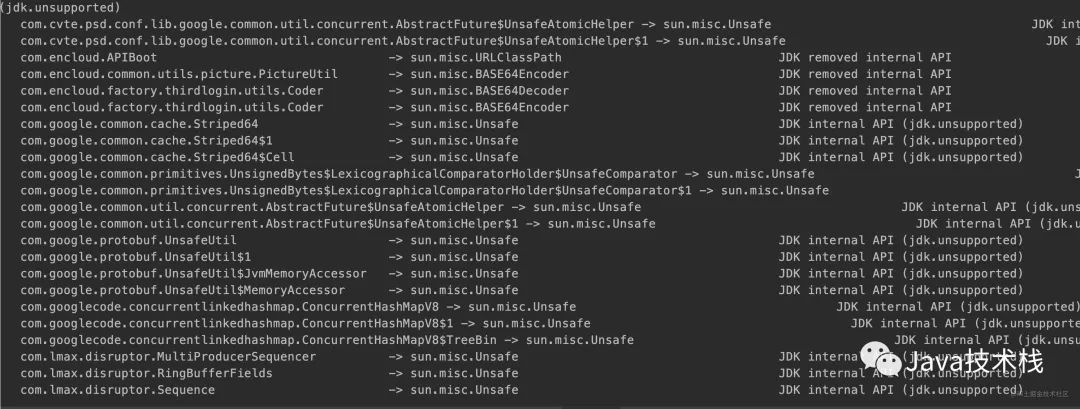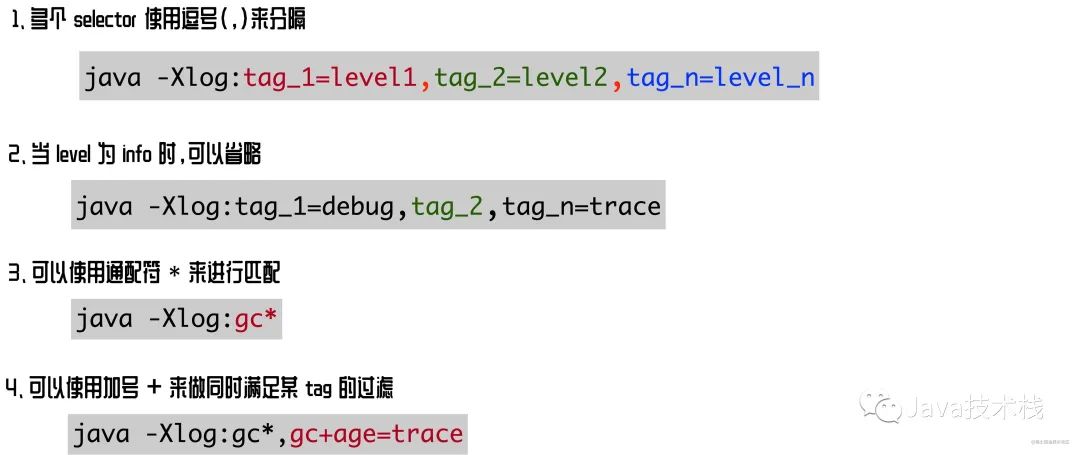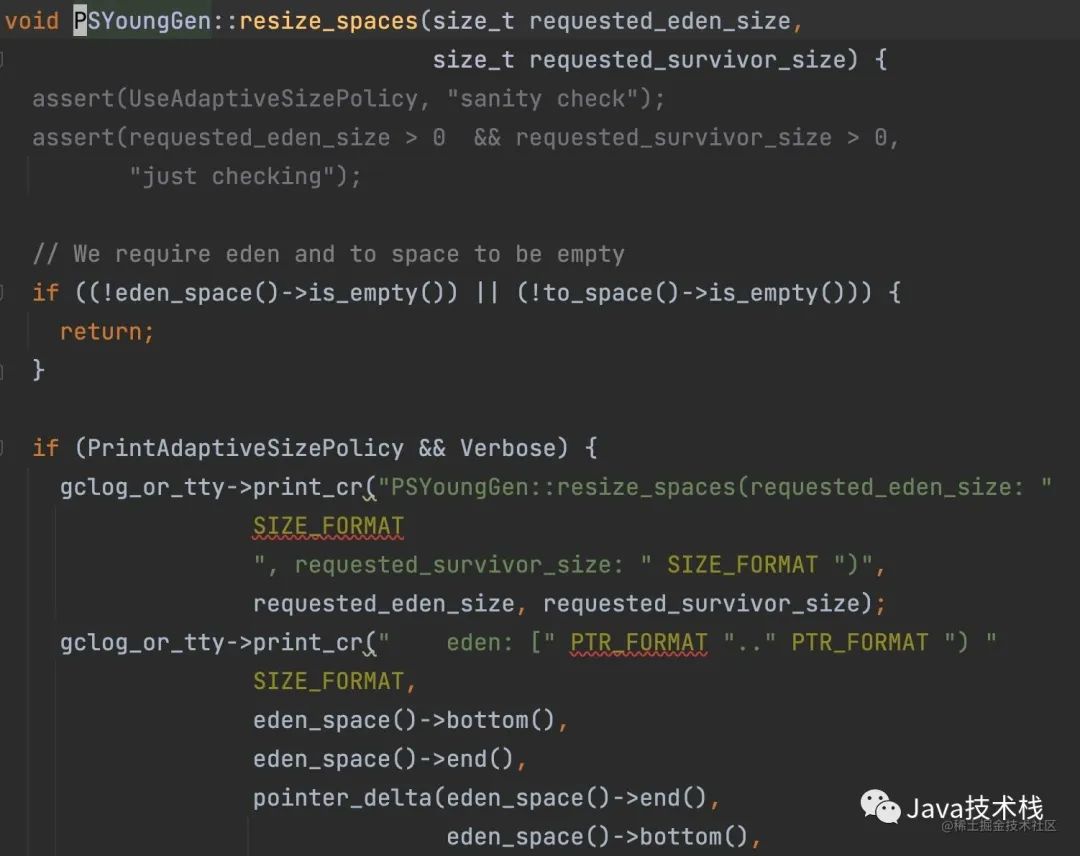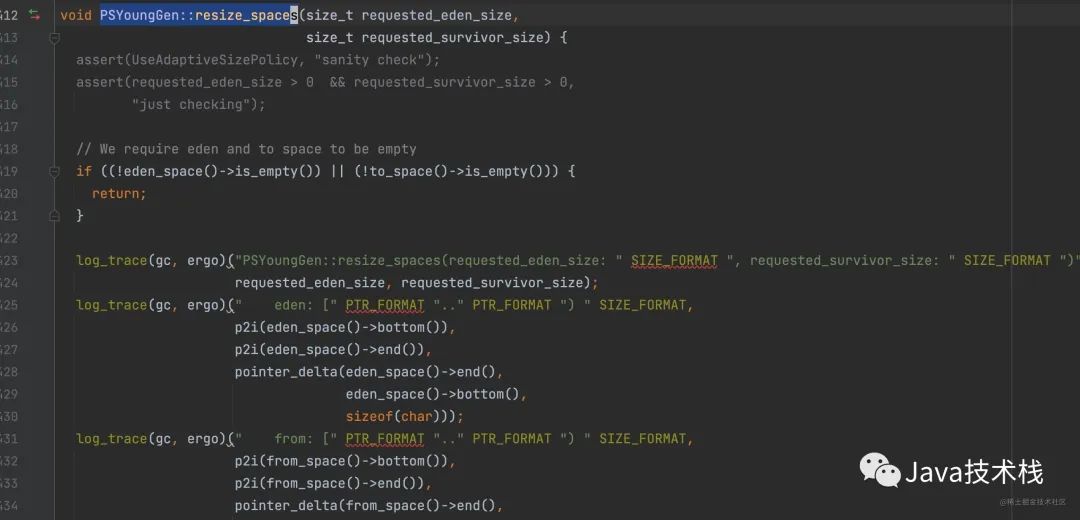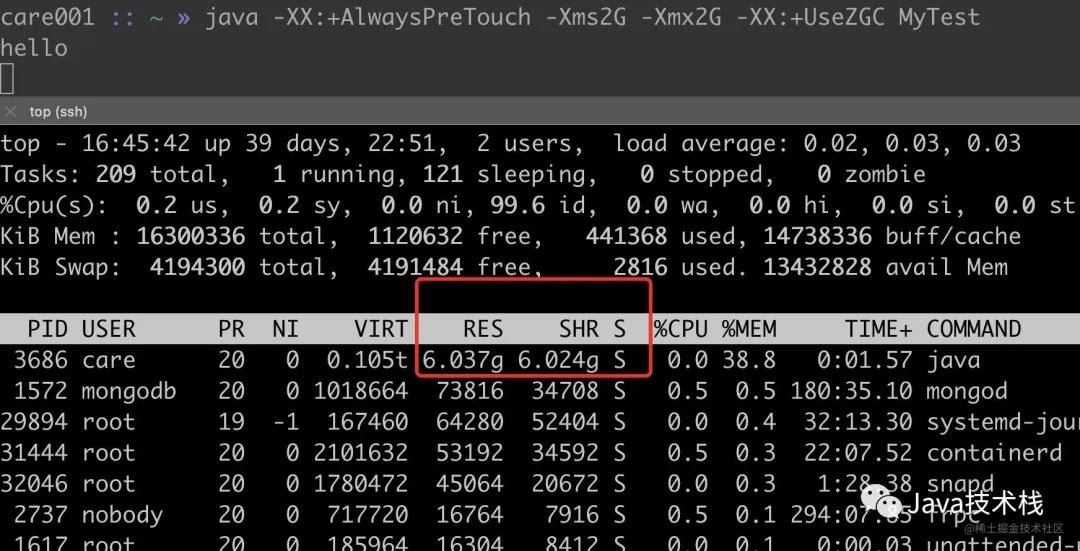你还在用 Java 8?手把手教你从 Java 8 升级到 Java 17 全过程,真香!!
点击关注公众号,Java干货及时送达
作者:挖坑的张师傅
来源:https://juejin.cn/user/430664257374270
Java 8 是旧时代的 Java 6,还不快升级,😄。
最近在做 Java8 到 Java17 的迁移工作,前期做了一些准备,过程中的一些信息记录如下(持续更新。。。)
分为几个部分:
编译相关 参数迁移相关 运行相关
编译相关
JEP 320
在 Java11 中引入了一个提案 JEP 320: Remove the Java EE and CORBA Modules 提案,移除了 Java EE and CORBA 的模块,如果项目中用到需要手动引入。比如代码中用到了 javax.annotation.* 下的包:
import javax.annotation.PreDestroy;
public abstract class FridayAgent
@PreDestroy
public void destroy() {
agentClient.close();
}
}
在编译时会找不到相关的类。这是因为 Java EE 已经在 Java 9 中被标记为 deprecated,Java 11 中被正式移除,可以手动引入 javax 的包:
<dependency>
<groupId>javax.annotation</groupId>
<artifactId>javax.annotation-api</artifactId>
<version>1.3.2</version>
</dependency>
使用了 sun.misc.* 下的包
比如 sun.misc.BASE64Encoder,这个简单,替换一下工具类即可。
[ERROR] symbol: class BASE64Encoder
[ERROR] location: package sun.misc
netty 低版本使用了 sun.misc.*,编译错误信息如下
Caused by: java.lang.NoClassDefFoundError: Could not initialize class io.netty.util.internal.PlatformDependent0
at io.netty.util.internal.PlatformDependent.getSystemClassLoader(PlatformDependent.java:694) ~[netty-all-4.0.42.Final.jar!/:4.0.42.Final]
对应的源码如下:
/**
* The {@link PlatformDependent} operations which requires access to {@code sun.misc.*}.
*/
final class PlatformDependent0 {
}
https://github.com/netty/netty/issues/6855
lombok 使用了 com.sun.tools.javac.* 下的包
错误信息如下:
Failed to execute goal org.apache.maven.plugins:maven-compiler-plugin:3.2:compile (default-compile) on project encloud-common: Fatal error compiling: java.lang.ExceptionInInitializerError: Unable to make field private com.sun.tools.javac.processing.JavacProcessingEnvironment$DiscoveredProcessors com.sun.tools.javac.processing.JavacProcessingEnvironment.discoveredProcs accessible: module jdk.compiler does not "opens com.sun.tools.javac.processing" to unnamed module
如果你的项目中使用 lombok,而且是低版本的话,就会出现,lombok 的原理是在编译期做一些手脚,用到了 com.sun.tools.javac 下的文件,升级到最新版可以解决。ps,个人很不喜欢 lombok, 调试的时候代码和 class 对不上真的很恶心。
<dependency>
<groupId>org.projectlombok</groupId>
<artifactId>lombok</artifactId>
<!-- <version>1.16.4</version>-->
<version>1.18.24</version>
</dependency>
kotlin 版本限制
我们后端在很多年前就 all-in Kotlin,Kotlin 的升级也是我们的重中之重。
[ERROR] Failed to execute goal org.jetbrains.kotlin:kotlin-maven-plugin:1.2.71:compile (compile) on project encloud-core: Compilation failure [ERROR] Unknown JVM target version: 17 [ERROR] Supported versions: 1.6, 1.8
Kotlin 在 1.6.0 版本开始支持 Java17 的字节码,低于 1.6.0 的编译会直接报错。
废弃依赖分析
可以用 jdeps --jdk-internals --multi-release 17 --class-path . encloud-api.jar 来做项目的依赖分析
这样你就可以知道哪些库需要做升级了。
推荐一个开源免费的 Spring Boot 最全教程:
https://github.com/javastacks/spring-boot-best-practice
参数迁移
什么是 Unified Logging
在 Java 领域,有广为人知的日志框架,slf4j、log4j 等,这些框架提供了统一的编程接口,让用户可以通过简单的配置实现日志输出的个性化配置,比如日志 tag、级别(info、debug 等)、上下文(线程 id、行号、时间等),在 JVM 内部之前一直缺乏这样的规范,于是出来了 Unified Logging,实现了日志格式的大一统,这就是我们接下来要介绍的重点 Unified Logging。
我们接触最多的是 gc 的日志,在 java8 中,我们配置 gc 日志的参数是 -Xloggc:/tmp/gc.log。在 JVM 中除了 GC,还有大量的其它相关的日志,比如线程、os 等,在新的 Unified Logging 日志中,日志输出的方式变更为了 java -Xlog:xxx,GC 不再特殊只是做为日志的一种存在形式。
java -Xlog -version
输出结果如下:
可以看到日志输出里,不仅有 GC 相关的日志,还有 os 线程相关的信息。事实上 java 的日志的生产者有非常多部分,比如 thread、class load、unload、safepoint、cds 等。
归根到底,日志打印,需要回答清楚三个问题:
what:要输出什么信息(tag),以什么日志级别输出(level) where:输出到哪里(console 还是 file) decorators:日志如何
输出什么信息(selectors)
首先来看 what 的部分,如何指定要输出哪些信息,这个在 JVM 内部被称之为 selectors。
JVM 采用的是 <tag-set>=<level>的形式来表示 selectors,默认情况下,tag 为all,表示所有的 tag,level 为 INFO,java -Xlog -version 等价于下面的形式
java -Xlog:all=info -version
如果我们想输出tag 为 gc,日志级别为 debug 的日志,可以用 java -Xlog:gc=debug 的形式:
$ java -Xlog:gc=debug -version
[0.023s][info][gc] Using G1
[0.023s][debug][gc] ConcGCThreads: 3 offset 22
[0.023s][debug][gc] ParallelGCThreads: 10
[0.024s][debug][gc] Initialize mark stack with 4096 chunks, maximum 524288
这样就输出了 tag 为 gc,级别为 debug 的日志信息。《46 张 PPT 弄懂JVM 调优》分享给你看下。
不过这里有一个比较坑的点是,这里的 tag 匹配规则是精确匹配,如果某条日志的 tag 是 gc,metaspace,通过上面的规则是匹配不到的,我们可以手动指定的方式来输出。
$ java -Xlog:gc+metaspace -version
[0.022s][info][gc,metaspace] CDS archive(s) mapped at: ... size 12443648.
[0.022s][info][gc,metaspace] Compressed class space mapped at: reserved size:...
[0.022s][info][gc,metaspace] Narrow klass base:..., Narrow
klass shift: 0, Narrow klass range: 0x100000000
这里的 selector 也是可以进行组合的,不同的 selector 之间用逗号分隔即可。比如同时输出 gc 和 gc+metaspace 这两类 tag 的日志,就可以这么写:
$ java -Xlog:gc=debug,gc+metaspace -version
[0.020s][info][gc] Using G1
[0.020s][debug][gc] ConcGCThreads: 3 offset 22
[0.020s][debug][gc] ParallelGCThreads: 10
[0.020s][debug][gc] Initialize mark stack with 4096 chunks, maximum 524288
[0.022s][info ][gc,metaspace] CDS archive(s) mapped at:
[0.022s][info ][gc,metaspace] Compressed class space mapped at:
[0.022s][info ][gc,metaspace] Narrow klass base: 0x0000000800000000
当然这么搞是很麻烦的,JVM 提供了通配符 * 来解决精确匹配的问题,比如我们想要所有 tag 为 gc 的日志,可以这么写:
$ java -Xlog:gc*=debug -version
[0.024s][debug][gc,heap] Minimum heap 8388608
[0.024s][info ][gc ] Using G1
[0.024s][debug][gc,heap,coops] Heap address: 0x0000000707400000
[0.024s][debug][gc ] ConcGCThreads: 3 offset 22
[0.024s][debug][gc ] ParallelGCThreads: 10
[0.024s][debug][gc ] Initialize mark stack with 4096 chunks
[0.024s][debug][gc,ergo,heap ] Expand the heap. requested expansion amount:
[0.025s][debug][gc,heap,region] Activate regions [0, 125)[0.025s][debug][gc,ihop ] Target occupancy update: old: 0B, new: 262144000B
[0.025s][debug][gc,ergo,refine] Initial Refinement Zones: green: 2560
[0.026s][debug][gc,task ] G1 Service Thread
[0.026s][debug][gc,task ] G1 Service Thread (Periodic GC Task) (register)
[0.026s][info ][gc,init ] Version: 17.0.3+7 (release)
...
如果只想要 INFO 级别的日志,则可以省略 level 的设置,使用 java -Xlog:gc* -version 即可。
如果想知道有哪些个性化的 tag 可以选择,可以用 java -Xlog:help 来找到所有可用的 tag。
阶段性小结
第二部分:输出到哪里(output)
默认情况下,日志会输出到 stdout,jvm 支持以下三种输出方式:
stdout stderr file
一般而言我们会把日志输出到文件中,方便后续进一步分析
-Xlog:all=debug:file=/path_to_logs/app.log
还可以指定日志切割的大小和方式
-Xlog:gc*:file=/path_to_logs/app.log:filesize=104857600,filecount=5
第三部分:日志 decorators
每条日志除了正常的信息以外,还有不少日志相关的上下文信息,在 jvm 中被称为 decorators,有下面这些可选项。
另外,如果你近期准备面试跳槽,建议在Java面试库小程序在线刷题,涵盖 2000+ 道 Java 面试题,几乎覆盖了所有主流技术面试题。
| Option | Description |
|---|---|
| time | Current time and date in ISO-8601 format. |
| uptime | Time since the start of the JVM in seconds and milliseconds (e.g., 6.567s). |
| timemillis | The same value as generated by System.currentTimeMillis(). |
| uptimemillis | Milliseconds since the JVM started. |
| timenanos | The same value as generated by System.nanoTime(). |
| uptimenanos | Nanoseconds since the JVM started. |
| pid | The process identifier. |
| tid | The thread identifier. |
| level | The level associated with the log message. |
| tags | The tag-set associated with the log message. |
比如可以用 java -Xlog:all=debug:stdout:level,tags,time,uptime,pid -version 选项来打印日志。
[2022-06-15T19:54:01.529+0800][0.001s][5235][info ][os,thread] Thread attached
[2022-06-15T19:54:01.529+0800][0.001s][5235][debug][os,thread] Thread 5237 stack...
[2022-06-15T19:54:01.529+0800][0.001s][5235][debug][perf,datacreation]
Unified Logging 小结
输出格式如下:
-Xlog:[selectors]:[output]:[decorators][:output-options]
selectors 是多个 tag 和 level 的组合,起到了 what(过滤器)的作用,格式为 tag1[+tag2...][*][=level][,...]decorators 是日志相关的描述信息,也可以理解为上下文 output 是输出相关的选项,一般我们会配置为输出到文件,按文件大小切割
这里补充一个知识点,就是默认值:
tag:all level:info output:stdout decorators: uptime, level, tags
GC 参数迁移
可以看到 GC 相关的参数都已经收拢到 Xlog 下,以前的很多 Java8 下的参数已经被移除或者标记为过期。
比如 PrintGCDetails 已经被 -Xlog:gc* 取代:
java -XX:+PrintGCDetails -version
[0.001s][warning][gc] -XX:+PrintGCDetails is deprecated. Will use -Xlog:gc* instead.
常见的标记为废弃的参数还有 -XX:+PrintGC 和 -Xloggc:<filepath>,迁移前后的参数如下:
| 旧参数 | 新参数 |
|---|---|
| -XX:+PrintGCDetails | -Xlog:gc* |
| -XX:+PrintGC | -Xlog:gc |
-Xloggc:<filepath> | -Xlog:gc:file=<filepath> |
除此之外,大量的 GC 的参数被移除,比如常用的参数 -XX:+PrintTenuringDistribution,Java17 会拒绝启动
java -XX:+PrintTenuringDistribution -version
Unrecognized VM option 'PrintTenuringDistribution'
Error: Could not create the Java Virtual Machine.
Error: A fatal exception has occurred. Program will exit.
更详细的移除的参数如下
CMSDumpAtPromotionFailure,
CMSPrintEdenSurvivorChunks,
GlLogLevel,
G1PrintHeapRegions,
G1PrintRegionLivenessInfo,
G1SummarizeConcMark,
G1SummarizeRSetStats,
G1TraceConcRefinement,
G1TraceEagerReclaimHumongousObjects,
G1TraceStringSymbolTableScrubbing,
GCLogFileSize, NumberofGCLogFiles,
PrintAdaptiveSizePolicy,
PrintclassHistogramAfterFullGC,
PrintClassHistogramBeforeFullGC,
PrintCMSInitiationStatistics
PrintCMSStatistics,
PrintFLSCensus,
PrintFLSStatistics,
PrintGCApplicationConcurrentTime
PrintGCApplicationStoppedTime,
PrintGCCause,
PrintGCDateStamps,
PrintGCID,
PrintGCTaskTimeStamps,
PrintGCTimeStamps,
PrintHeapAtGC,
PrintHeapAtGCExtended,
PrintJNIGCStalls,
PrintOldPLAB
PrintParallel0ldGCPhaseTimes,
PrintPLAB,
PrintPromotionFailure,
PrintReferenceGC,
PrintStringDeduplicationStatistics,
PrintTaskqueue,
PrintTenuringDistribution,
PrintTerminationStats,
PrintTLAB,
TraceDynamicGCThreads,
TraceMetadataHumongousAllocation,
UseGCLogFileRotation,
VerifySilently
这些移除的参数大部分都能在新的日志体系下找到对应的参数,比如 PrintHeapAtGC 这个参数可以用 -Xlog:gc+heap=debug 来替代
$ java -Xlog:gc+heap=debug -cp . G1GCDemo01
[0.004s][debug][gc,heap] Minimum heap 8388608 Initial heap 268435456 Maximum heap
hello, g1gc!
[12.263s][debug][gc,heap] GC(0) Heap before GC invocations=0 (full 0):
[12.265s][debug][gc,heap] GC(0) garbage-first heap
[12.265s][debug][gc,heap] GC(0) region size 2048K, 1 young (2048K)
[12.265s][debug][gc,heap] GC(0) Metaspace used 3678K
[12.265s][debug][gc,heap] GC(0) class space used 300K
[12.280s][debug][gc,heap] GC(0) Uncommittable regions after shrink: 124
虽然理解起来不太直观,不过要记住 -XX:+PrintGCApplicationStoppedTime 和 -XX+PrintGCApplicationConcurrentTime 这两个参数一起被 -Xlog:safepoint 取代。
点击关注公众号,Java干货及时送达
还有一个常见的参数 -XX:+PrintAdaptiveSizePolicy 被 -Xlog:gc+ergo*=trace 取代,
[0.122s][debug][gc, ergo, refine] Initial Refinement Zones: green: 23, yellow:
69, red: 115, min yellow size: 46
[0.142s ][debug][gc, ergo, heap ] Expand the heap. requested expansion amount: 268435456B expansion amount: 268435456B
[2.475s][trace][gc, ergo, cset] GC(0) Start choosing CSet. pending cards: 0 predicted base time: 10.00ms remaining time:
190.00ms target pause time: 200.00ms
[2.476s][trace][gc, ergo, cset ] GC(9) Add young regions to CSet. eden: 24 regions, survivors: 0 regions, predicted young
region time: 367.19ms, target pause time: 200.00ms
[2.476s ][debug][gc, ergo, cset ] GC(0) Finish choosing CSet. old: 0 regions, predicted old region time: 0.00ms, time
remaining: 0.00
[2.826s][debug][gc, ergo] GC(0) Running G1 Clear Card Table Task using 1 workers for 1 units of work for 24 regions.
[2.827s][debug][gc, ergo] GC (0) Running G1 Free Collection Set using 1 workers for collection set length 24
[2.828s][trace][gc, ergo, refine] GC(0) Updating Refinement Zones: update rs time: 0.004ms, update rs buffers: 0, update rs
goal time: 19.999ms
[2.829s][debug][gc, ergo, refine] GC(0) Updated Refinement Zones: green: 23, yellow: 69, red: 115
[3.045s][trace][gc, ergo, set ] GC(1) Start choosing CSet. pending cards: 5898 predicted base time: 26.69ms remaining
time: 173.31ms target pause time: 200.00ms
[3.045s][trace][gc, ergo, cset ] GC(1) Add young regions to Set. eden: 9 regions, survivors: 3 regions, predicted young
region time: 457.38ms, target pause time: 200.00ms
[3.045s][debug](gc, ergo, set ] GC(1) Finish choosing CSet. old: @ regions, predicted old region time: 0.00ms, time
remaining: 0.00
[3.090s ][debug][gc, ergo
] GC (1) Running G1 Clear Card Table Task using 1 workers for 1 units of work for 12 regions.
[3.091s][debug][gc, ergo
GC (1) Running G1 Free Collection Set using 1 workers for collection set length 12
[3.093s][trace][gc, ergo, refine] GC(1) Updating Refinement Zones: update rs time: 2.510ms, update rs buffers: 25, update rs
goal time: 19.999ms
[3.093s ][debug][gc, ergo, refine] GC(1) Updated Refinement Zones: green: 25, yellow: 75, red: 125
看一下这部分的源码的变迁,就可以知道确实是如此了,在 Java8 中,PSYoungGen::resize_spaces代码如下:
在 Java17 中,这部分日志打印被 gc+ergo 的标签日志取代:
还有一个分代 GC 中非常有用的参数 -XX:+PrintTenuringDistribution,现在被 gc+age=trace 取代。
完整的参数变迁对应表如下:
| 旧 GC 参数 -XX:+… | 对应新 GC 参数 | GC 参数含义 |
|---|---|---|
| PrintGC -Xloggc: | gc | Print message at garbage collection |
| PrintGCDetails -Xloggc: | gc* | Print more details at garbage collection |
| -verbose:gc | gc=trace gc+heap=trace gc+heap+exit=trace gc+metaspace=trace gc+sweep=debug gc+heap+ergo=debug | Verbose GC |
| PrintGCCause | GC cause is now always logged | Include GC cause in GC logging |
| PrintGCID | GC ID is now always logged | Print an identifier for each garbage collection |
| PrintGCApplicationStoppedTime | safepoint | Print the time the application has been stopped |
| PrintGCApplicationConcurrentTime | safepoint | Print the time the application has been running |
| PrintTenuringDistribution | gc+age*=trace | Print tenuring age information |
| PrintAdaptiveSizePolicy | gc+ergo*=trace | Print information about AdaptiveSizePolicy |
| PrintHeapAtGC | gc+heap=debug | Print heap layout before and after each GC |
| PrintHeapAtGCExtended | gc+heap=trace | Print extended information about the layout of the heap when -XX:+PrintHeapAtGC is set |
| PrintClassHistogramBeforeFullGC | classhisto*=trace | Print a class histogram before any major stop-world GC |
| PrintClassHistogramAfterFullGC | classhisto*=trace | Print a class histogram after any major stop-world GC |
| PrintStringDeduplicationStatistics | gc+stringdedup*=debug | Print string deduplication statistics |
| PrintJNIGCStalls | gc+jni=debug | Print diagnostic message when GC is stalled by JNI critical section |
| PrintReferenceGC | gc+ref=debug | Print times spent handling reference objects during GC |
| PrintGCTaskTimeStamps | task*=debug | Print timestamps for individual gc worker thread tasks |
| PrintTaskQueue | gc+task+stats=trace | Print taskqueue statistics for parallel collectors |
| PrintPLAB | gc+plab=trace | Print (survivor space) promotion LAB’s sizing decisions |
| PrintOldPLAB | gc+plab=trace | Print (old gen) promotion LAB’s sizing decisions |
| PrintPromotionFailure | gc+promotion=debug | Print additional diagnostic information following promotion failure |
| PrintTLAB | gc+tlab=trace | Print various TLAB related information (augmented with -XX:+TLABStats) |
| PrintTerminationStats | gc+task+stats=debug | Print termination statistics for parallel collectors |
| G1PrintHeapRegions | gc+region=trace | If set G1 will print information on which regions are being allocated and which are reclaimed |
| G1PrintRegionsLivenessInfo | gc+liveness=trace | Prints the liveness information for all regions in the heap at the end of a marking cycle |
| G1SummarizeConcMark | gc+marking=trace | Summarize concurrent mark info |
| G1SummarizeRSets | gc+remset*=trace | Summarize remembered set processing info |
| G1TraceConcRefinement | gc+refine=debug | Trace G1 concurrent refinement |
| G1TraceEagerReclaimHumongousObjects | gc+humongous=debug | Print some information about large object liveness at every young GC |
| G1TraceStringSymbolTableScrubbing | gc+stringdedup=trace | Trace information string and symbol table scrubbing |
| PrintParallelOldGCPhaseTimes | gc+phases=trace | Print the time taken by each phase in ParallelOldGC |
| CMSDumpAtPromotionFailure | gc+promotion=trace | Dump useful information about the state of the CMS old generation upon a promotion failure (complemented by flags CMSPrintChunksInDump or CMSPrintObjectsInDump) |
| CMSPrintEdenSurvivorChunks | gc+heap=trace | Print the eden and the survivor chunks used for the parallel initial mark or remark of the eden/survivor spaces |
| PrintCMSInitiationStatistics | gc=trace | Statistics for initiating a CMS collection |
| PrintCMSStatistics | gc=debug (trace) gc+task=trace gc+survivor=trace log+sweep=debug (trace) | Statistics for CMS (complemented by CMSVerifyReturnedBytes) |
| PrintFLSCensus | gc+freelist+census=debug | Census for CMS' FreeListSpace |
| PrintFLSStatistics | gc+freelist+stats=debug (trace) gc+freelist*=debug (trace) | Statistics for CMS' FreeListSpace |
| TraceCMSState | gc+state=debug | Trace the state of the CMS collection |
| TraceSafepoint | safepoint=debug | Trace application pauses due to VM operations in safepoints |
| TraceSafepointCleanupTime | safepoint+cleanup=info | break down of clean up tasks performed during safepoint |
| TraceAdaptativeGCBoundary | heap+ergo=debug | Trace young-old boundary moves |
| TraceDynamicGCThreads | gc+task=trace | Trace the dynamic GC thread usage |
| TraceMetadataHumongousAllocation | gc+metaspace+alloc=debug | Trace humongous metadata allocations |
| VerifySilently | gc+verify=debug |
举例
-XX:+PrintGCDetails \ // gc*
-XX:+PrintGCApplicationStoppedTime \ // safepoint
-XX:+PrintGCApplicationConcurrentTime \ // safepoint
-XX:+PrintGCCause \ // 默认会输出
-XX:+PrintGCID \ // 默认会输出
-XX:+PrintTenuringDistribution \ // gc+age*=trace
-XX:+PrintGCDateStamps \ // :time,tags,level
-XX:+UseGCLogFileRotation \ // :filecount=5,filesize=10M
-XX:NumberOfGCLogFiles=5 \ // :filecount=5,filesize=10M
-XX:GCLogFileSize=10M \ // :filecount=5,filesize=10M
-Xloggc:/var/log/`date +%FT%H-%M-%S`-gc.log \ // -Xlog::file=/var/log/%t-gc.log
变迁后:
-Xlog:
gc*,
safepoint,
gc+heap=debug,
gc+ergo*=trace,
gc+age*=trace,
:file=/var/log/%t-gc.log
:time,tags,level
:filecount=5,filesize=10M
推荐的配置
-Xlog:
// selections
codecache+sweep*=trace,
class+unload, // TraceClassUnloading
class+load, // TraceClassLoading
os+thread,
safepoint, // TraceSafepoint
gc*, // PrintGCDetails
gc+stringdedup=debug, // PrintStringDeduplicationStatistics
gc+ergo*=trace,
gc+age=trace, // PrintTenuringDistribution
gc+phases=trace,
gc+humongous=trace,
jit+compilation=debug
// output
:file=/path_to_logs/app.log
// decorators
:level,tags,time,uptime,pid
// output-options
:filesize=104857600,filecount=5
运行相关
反射+私有 API 调用之伤
在 Java8 中,没有人能阻止你访问特定的包,比如 sun.misc,对反射也没有限制,只要 setAccessible(true) 就可以了。Java9 模块化以后,一切都变了,只能通过 --add-exports 和 --add-opens 来打破模块封装
--add-opens导出特定的包--add-opens允许模块中特定包的类路径深度反射访问
比如:
--add-opens java.base/java.lang=ALL-UNNAMED
--add-opens java.base/java.io=ALL-UNNAMED
--add-opens java.base/java.math=ALL-UNNAMED
--add-opens java.base/java.net=ALL-UNNAMED
--add-opens java.base/java.nio=ALL-UNNAMED
--add-opens java.base/java.security=ALL-UNNAMED
--add-opens java.base/java.text=ALL-UNNAMED
--add-opens java.base/java.time=ALL-UNNAMED
--add-opens java.base/java.util=ALL-UNNAMED
--add-opens java.base/jdk.internal.access=ALL-UNNAMED
--add-opens java.base/jdk.internal.misc=ALL-UNNAMED
关于 GC 算法的选择
CMS 正式退出历史舞台,G1 正式接棒,ZGC 蓄势待发。在GC 算法的选择上,目前来看 G1 还是最佳的选择,ZGC 因为有内存占用被 OS 标记过高(三倍共享内存)虚高的问题,进程可能被 OOM-killer 杀掉。
ZGC 三倍 RES 内存
ZGC 底层用到了一个称之为染色指针的技术,使用三个视图(Marked0、Marked1 和 Remapped)来映射到同一块共享内存区域,原理如下:
#include <iostream>
#include <sys/mman.h>
#include <sys/stat.h>
#include <fcntl.h>
#include <unistd.h>
#include <cstdio>
#include <cstdlib>
int main() {
// shm_open()函数用来打开或者创建一个共享内存区,两个进程可以通过给shm_open()函数传递相同的名字以达到操作同一共享内存的目的
int fd = ::shm_open("/test", O_RDWR | O_CREAT | O_EXCL, 0600);
if (fd < 0) {
shm_unlink("/test");
perror("shm open failed");
return 0;
}
size_t size = 1 * 1024 * 1024 * 1024;
// 创建一个共享内存后,默认大小为0,所以需要设置共享内存大小。ftruncate()函数可用来调整文件或者共享内存的大小
::ftruncate(fd, size);
int prot = PROT_READ | PROT_WRITE;
// 创建共享内存后,需要将共享内存映射到调用进程的地址空间,可通过mmap()函数来完成
uint32_t *p1 = (uint32_t *) (mmap(nullptr, size, prot, MAP_SHARED, fd, 0));
uint32_t *p2 = (uint32_t *) (mmap(nullptr, size, prot, MAP_SHARED, fd, 0));
uint32_t *p3 = (uint32_t *) (mmap(nullptr, size, prot, MAP_SHARED, fd, 0));
::close(fd);
*p1 = 0xcafebabe;
::printf("Address of addr1: %p, value is 0x%x\n", p1, *p1);
::printf("Address of addr2: %p, value is 0x%x\n", p2, *p2);
::printf("Address of addr3: %p, value is 0x%x\n", p3, *p3);
::getchar();
*p2 = 0xcafebaba;
::printf("Address of addr1: %p, value is 0x%x\n", p1, *p1);
::printf("Address of addr2: %p, value is 0x%x\n", p2, *p2);
::printf("Address of addr3: %p, value is 0x%x\n", p3, *p3);
::getchar();
munmap(p1, size);
munmap(p2, size);
munmap(p3, size);
shm_unlink("/test");
std::cout << "hello" << std::endl;
}
你可以想象 p1、p2、p3 这三块内存区域就是 ZGC 中三种视图。
但是在 linux 统计中,虽然是共享内存,但是依然会统计三次,比如 RES。
同一个应用,使用 G1 RES 显示占用 2G,ZGC 则显示占用 6G
java -XX:+AlwaysPreTouch -Xms2G -Xmx2G -XX:+UseZGC MyTest
java -XX:+AlwaysPreTouch -Xms2G -Xmx2G -XX:+UseG1GC MyTest
接下面我们讨论的都是 G1 相关的。
G1 参数调整
不要配置新生代的大小
这个在《JVM G1 源码分析和调优》一书里有详细的介绍,有两个主要的原因:
G1对内存的管理是不连续的,重新分配一个分区代价很低 G1 的需要根据目标停顿时间动态调整搜集的分区的个数,如果不能调整新生代的大小,那么 G1 可能不能满足停顿时间的要求
诸如 -Xmn, -XX:NewSize, -XX:MaxNewSize, -XX:SurvivorRatio 都不要在 G1 中出现,只需要控制最大、最小堆和目标暂停时间即可
调整 -XX:InitiatingHeapOccupancyPercent 到合适的值
IHOP 默认值为 45,这个值是启动并发标记的先决条件,只有当老年代内存栈总空间的 45% 之后才会启动并发标记任务。
增加这个值:导致并发标记可能花费更多的时间,同时导致 YGC 和 Mixed-GC 收集时的分区数变少,可以根据整体应用占用的平均内存来设置。
End
Stream 中的 map、peek、foreach 方法的区别?


